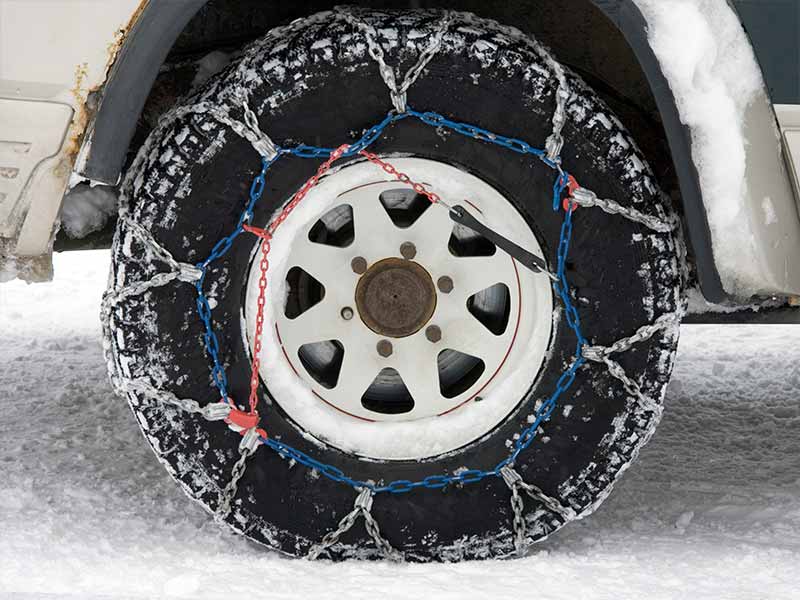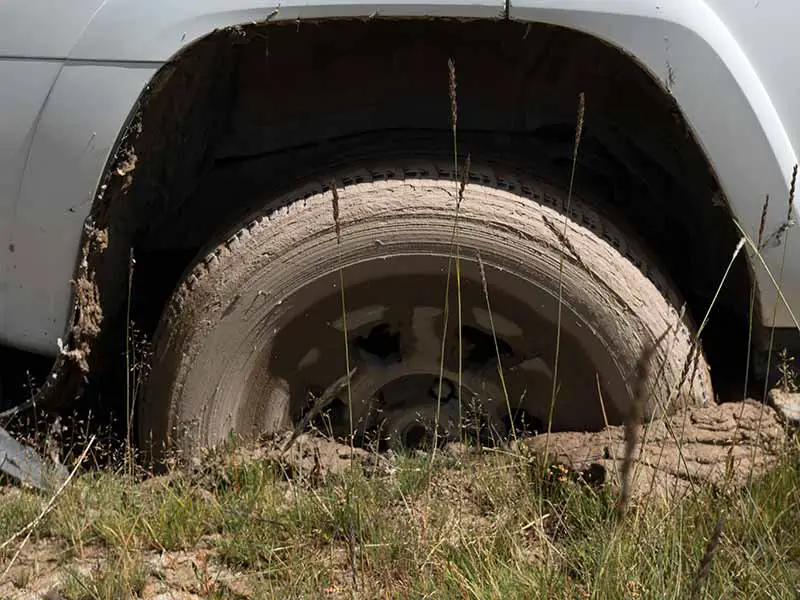Have you ever found yourself wondering if snow chains can really help when you’re stuck in a muddy off-road situation? Imagine you’re planning an off-road adventure, and the forecast shows rain and mud along your path. Knowing whether snow chains can give you that extra grip in muddy conditions could be the key to a successful trip.
Can You Use Snow Chains In Mud?
Yes, snow chains can be used in mud, but their effectiveness is limited, especially in deep mud. They are better suited for snow and ice.
In this article, we explore the use of snow chains in off-road conditions, particularly in mud, and offer practical advice and alternatives for safer and more effective driving.

Understanding Snow Chains and Their Primary Use
I’ve seen how important it is to choose the right type of equipment for your vehicle, especially when it comes to things like snow chains. Snow chains are special chains that you put on your car or truck tires. They help you drive safely in snowy and icy conditions. Here’s what you need to know about them.
What Are Snow Chains?
- Snow Chains: These are chains made of metal that you wrap around your tires. They’re designed to give your tires better grip on roads that are covered in snow or ice. Think of them like shoes with special soles that stop you from slipping on ice.
How Do Snow Chains Work?
- Better Grip: Snow chains dig into the snow and ice. This gives your tires more grip, so you don’t slide around.
- Useful in Winter: They are really helpful in winter, especially when the roads are very snowy or icy.
Snow Chains vs. Snow Tires
- Snow Tires: These are special tires made for snowy weather. They have a different design than regular tires to help move through snow better.
- Chains for Extra Safety: Sometimes, even with snow tires, you might need extra help. That’s where snow chains come in. They add extra grip to your snow tires.
When Should You Use Snow Chains?
- In Snowy and Icy Conditions: You should use snow chains when there’s a lot of snow or ice on the road. They’re not for everyday use.
- Check Local Laws: Some places have laws about when you can or must use snow chains. It’s a good idea to know these rules if you live in or are traveling to a snowy place.
Tips for Using Snow Chains
- Right Size and Fit: Make sure you get the right size chains for your tires. If they’re too big or too small, they won’t work well and could damage your tires.
- Follow Instructions: It’s important to put them on your tires correctly. Follow the instructions that come with the chains.

Snow Chains in Off-Road Conditions
I’ve been asked before about the use of snow chains for off-road driving, especially on dirt roads and through tough terrains like deep mud or packed snow. From my experience, it’s crucial to understand how snow chains can help and sometimes why they might not be the best choice in certain off-road situations.
Using Snow Chains on Dirt Roads
- Extra Traction: On dirt roads, especially those that are wet or have loose soil, snow chains can provide extra traction. This means your tires can grip the road better, which is important for safe driving.
- Careful Driving: It’s important to drive carefully even with chains. Going too fast or being rough with your steering can still lead to problems.
Snow Chains in Deep Mud
- Limited Effectiveness: Snow chains are not always the best choice in deep mud. They can help a bit, but sometimes they can get clogged with mud, making them less effective.
- Risk of Damage: There’s also a risk that the chains can damage your tires if they’re not used correctly in these conditions.
Snow Chains on Packed Snow
- Ideal Conditions: Packed snow is where snow chains really shine. They dig into the snow, giving your tires the grip they need to prevent sliding.
The Challenge of Different Terrains
- Terrain Matters: The effectiveness of snow chains largely depends on the type of terrain you’re driving on. For example, what works on packed snow might not work as well in deep mud.
- Be Prepared: If you’re planning to drive off-road, it’s important to be prepared for different kinds of surfaces and to know what your snow chains can and cannot do.
Alternatives for Off-Road Driving
- Mud Tires: For deep mud, consider using specialized mud tires. These are designed to handle muddy conditions better than regular tires or snow chains.
- Adjusting for Terrain: Sometimes, it’s about choosing the right equipment for the specific terrain you’ll be driving on.

The Limitations of Snow Chains in Mud
In my experience with off-roading and dealing with various tire setups, I’ve found that while snow chains are great for icy and snowy conditions, their effectiveness can be quite limited in mud, especially deep mud. Understanding these limitations is key to ensuring both your safety and the well-being of your vehicle.
Why Snow Chains May Struggle in Mud
- Clogging Issues: Snow chains can easily get clogged with mud. When this happens, they lose their ability to provide the necessary grip, making them less effective.
- Damage Risk: In muddy conditions, chains can slip and slide on the tire surface, potentially causing damage to both the tire and the wheel.
Comparing Snow Chains to Mud Tires
- Mud Tires: Unlike snow chains, mud tires are specifically designed to handle muddy conditions. They have deep, wide treads that help clear mud away and maintain traction.
- Effectiveness in Mud: While snow chains add grip on snow and ice, mud tires are the better choice for deep mud because of their design and material.
Making the Right Choice
- Understanding Conditions: It’s crucial to assess the conditions you’ll be driving in. If you expect deep mud, it might be better to opt for mud tires instead of relying on snow chains.
- Safety and Performance: Always prioritize safety and vehicle performance. In muddy conditions, the wrong choice can lead to getting stuck or even causing an accident.

Safety Considerations When Using Chains
As someone who has seen a fair share of tire and vehicle setups, I can’t emphasize enough the importance of safety when using snow chains. It’s not just about putting them on your tires; it’s about making sure they’re used correctly to avoid any potential risks.
Proper Fitting of Snow Chains
- Right Size for Your Tires: Ensuring that the snow chains fit your tires correctly is crucial. If they’re too loose, they might come off; if they’re too tight, they can damage the tire.
- Placement on Tires: Typically, chains should be fitted on the drive tires of the vehicle. If you have a front-wheel-drive car, they go on the front tires, and for rear-wheel drives, on the rear tires.
Potential Risks of Incorrect Use
- Damage to Tires and Vehicle: Incorrectly fitted chains can cause damage not only to the tires but also to the vehicle itself, like scratching the wheel wells or even impacting the brake line.
- Reduced Vehicle Control: If chains are not fitted properly, they can reduce your control over the vehicle, making driving unsafe.
How to Carry and Store Chains
- Carrying Chains: It’s always good practice to carry chains in your vehicle during winter months or if you’re heading to a snowy area.
- Storing When Not in Use: When not in use, store them in a dry and easily accessible place in your vehicle. This way, they’re ready when you need them.
Tips for Safe Use
- Practice Fitting Them: Before you need to use them, practice putting the chains on your tires. This will make it easier when you have to do it in cold or snowy conditions.
- Check Regularly: Once fitted, check the chains regularly during your journey to ensure they stay tight and secure.

Alternatives to Snow Chains for Mud
From my years of working with different tire types and vehicle setups, I’ve learned that while snow chains are invaluable in icy and snowy conditions, they are not always the best choice for muddy environments. In situations where mud is a major concern, there are alternatives to snow chains that can provide better traction and safety.
Exploring Mud Tires
- Special Design for Mud: Mud tires are specifically designed for muddy conditions. They have large, deep tread patterns that help to grip and navigate through thick mud.
- Better Performance in Mud: Unlike snow chains, mud tires won’t get clogged with mud, allowing for consistent performance and traction.
Cable Chains and Snow Socks
- Cable Chains: These are a lighter alternative to traditional snow chains and can be used in milder muddy conditions. They offer better clearance and are less likely to damage your vehicle.
- Snow Socks: While not as robust as chains, snow socks can provide a bit of extra traction in lighter mud and are easier to install and remove.
Comparing Effectiveness in Muddy Conditions
- Terrain Suitability: It’s important to match your equipment to the terrain you expect to encounter. In deep mud, mud tires are more effective, while cable chains or snow socks might suffice for less severe conditions.
Making the Best Choice for Your Vehicle
- Assessing Your Needs: Consider the type of terrain you’ll be driving in most often and choose the equipment that best suits those conditions.
- Safety and Vehicle Compatibility: Always prioritize safety and ensure that whatever alternative you choose is compatible with your vehicle.

Practical Tips for Off-Road Driving
Whether you’re dealing with dirt tracks, muddy roads, or snow-covered paths, knowing how to navigate these terrains can make a big difference in your driving experience.
Using Chains and Tires Effectively
- Right Equipment for the Terrain: Choose your tire and chain setup based on the terrain. If you’re expecting deep mud, go for mud tires; for snow-covered roads, snow chains are your best bet.
- Driving Technique Matters: Your driving style should adapt to the equipment you’re using. For instance, with snow chains, it’s important to maintain a steady, moderate speed.
The Role of Wheel Drive Vehicles
- Understanding Your Vehicle’s Drive System: Knowing whether your vehicle is front-wheel drive, rear-wheel drive, or all-wheel drive can influence your choice of chains and tires.
- Using a Rear Locker: If you have a rear locker in your vehicle, it can provide additional traction in challenging off-road conditions. This is especially useful when navigating tricky terrains like deep mud or steep, slippery slopes.
Maintenance and Care of Equipment
- Regular Inspection: Regularly inspect your tires and chains for any signs of wear or damage. This is crucial for maintaining safety and performance.
- Proper Storage: When not in use, store your chains and off-road tires properly to prolong their life and maintain their effectiveness.
When to Consider New Tires
- Tread Depth: Keep an eye on the tread depth of your tires. Worn-out treads can significantly reduce traction and safety.
- Adapting to Conditions: If you frequently drive in off-road conditions, consider getting tires that are specifically designed for those environments.
Resources
Below are some links you may find helpful when learning about tires:
Final Thoughts
While snow chains can provide some traction in mud, they are not as effective as specialized mud tires, especially in deep mud. It’s important to choose the right equipment for your specific driving conditions, whether that’s snow chains for icy roads or mud tires for muddy trails.
Safety should always be your top priority, and being prepared with the right knowledge and equipment can make a significant difference in your off-road adventures.
Good luck and happy motoring.




